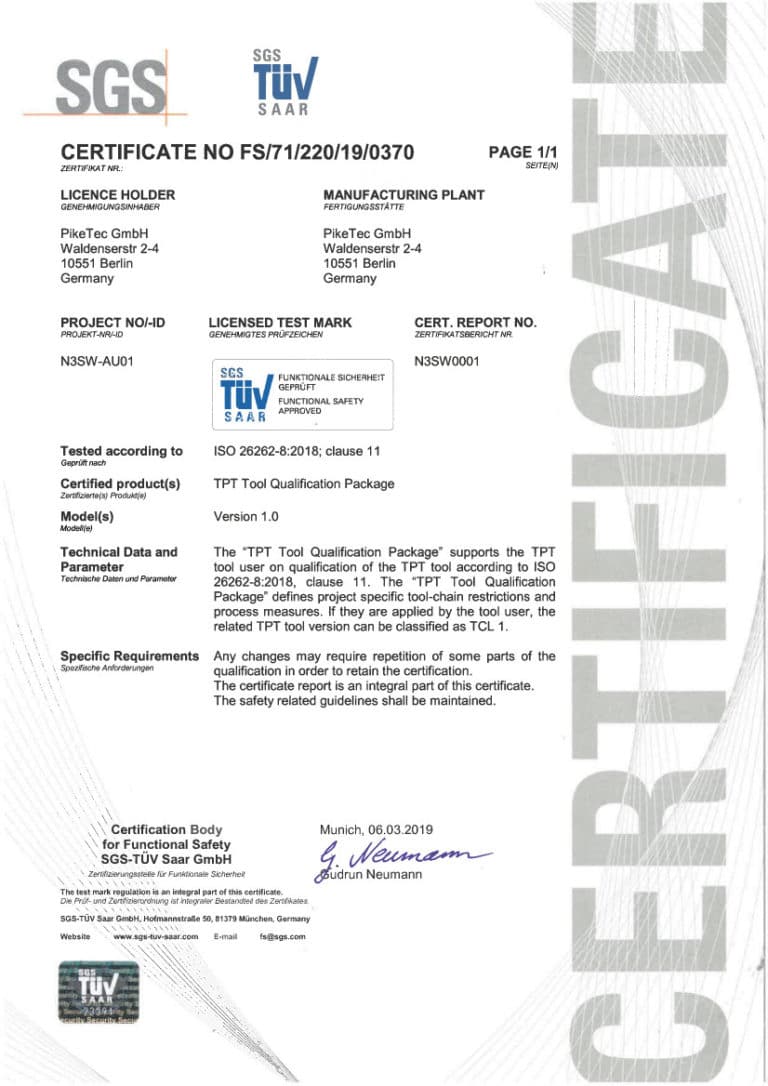
Safety, ISO 26262 and testing with TPT
The development of safety-relevant systems requires compliance with certain safety standards.
More and more electronic systems are being used in safety-critical areas where errors can have catastrophic consequences. Therefore a careful development is a must. To avoid hazards, safety standards such as IEC/EN 61508, DO178, EN50128 or ISO 26262 must be taken into account.
TPT provides you with the test tool that supports you along the (test) road and facilitates the development of a safety-relevant system in accordance with all of these standards. The required qualification of TPT can be easily implemented.
ISO 26262.
In the automotive sector, ISO 26262 “Functional Safety – Road vehicles” is relevant for this purpose. It applies to all automotive manufacturers (OEMs) and their suppliers worldwide.
“Functional” safety is intended to ensure that products can be operated safely – even if they fail. For example, your vehicle should only brake if the driver wants it to, but not in all other cases. The aim is therefore to prevent damage to people or the system environment – even if a system fails or runs incorrectly.
ISO 26262 compliant testing with TPT.
ISO 26262 aims to avoid hazardous situations. So-called Automotive Safety Integrity Levels (ASIL) are determined, ranging from ASIL-A (lowest level) to ASIL-D (highest level). For example, an air conditioning control unit has a relatively low risk (ASIL-A), while an emergency brake control unit at the highest safety level (ASIL-D) is safety-relevant.
For software development, ISO 26262 defines requirements for the various development phases. With TPT you have the test tool that optimally supports you up to ASIL-D. A qualification from TPT to ASIL-D is easy to implement.
TPT can be executed in several test environments
- Model-in-the-Loop testing (Simulink, TargetLink, ASCET)
- Software-in-the-Loop testing (C code, C++ code)
- Processor-in-the-Loop testing
- Hardware-in-the-Loop testing
- Vehicle (automated vehicle tests)
TPT supports among others:
- Test methods
- Requirements-based testing
- Interface test
- Fault injection test
- Resource usage evaluation
- Back-to-back test
- Coverage analysis (code coverage and requirements coverage)
- Methods to derive test cases
- Analysis of requirements
- Analysis of equivalence classes
- Analysis of limit values
- Test level
- Unit Test
- Software integration and test
- Verification of software safety requirements
- System: Item integration and test
- Test methods
Qualification of the testing tool.
In order to use TPT in the development of safety-relevant systems, a qualification is necessary from ASIL-A on, which proves the trustworthiness of the test tool for the use in a safety-relevant development. Showing the mandatory “confidence in use” is done in two steps:
1. Analysis and classification of the tool
2. Derivation and implementation of the qualification measures
We support you from the first analysis to the final qualification, from the first meeting to the completion of all necessary documents.
Qualification Package.
PikeTec offers a Qualification Package for TPT that efficiently supports tool qualification for all TPT users according to ISO 26262 and significantly minimizes the time and effort required. The Qualification Package is certified for the qualification of systems for safety integrity levels ASIL-A to ASIL-D. In other words, we can help you to qualify your tool chain, regardless of your application and fault case.
We qualify TPT according to the method of validation (required for ASIL-D).
Qualification package.
Our Qualification Package
- offers support in all matters of the tool qualification
- uses a generic qualification of TPT that only has to be supplemented for the specific development process.
- includes all documents that are required by ISO 26262
- is certified for the qualification of systems with the safety integrity level ASIL A up to ASIL D
Qualification support.
We assist you from the first analysis up to the final qualification, from the first conversation up to the completion of all necessary documents.
ISO 26262 certificate for PikeTec.
PikeTec’s “TPT Tool Qualification Package” is certified to ‘support TPT users on qualification of the TPT tool according to the ISO 26262-8:2018′ by TÜV Saar in Germany.
